By Bernie Barringer
I’d found this spot the previous year but I didn’t hunt it correctly. The location was a narrow stretch of trees connecting two larger woodlots along the banks of a large river. The area surrounding it was a couple hundred acres of tall native grasses. It’s the kind of spot that jumps off the screen at you when you see it on Google Earth. It’s what I call a classic rut funnel.
Despite the fact that it is on Kansas state public hunting land, I was the only one hunting it because of the difficulty in getting more than a mile and a half back into it, and of course, the prospect of getting a buck out of there. If this spot was within a half-mile of the road, I probably wouldn’t be alone in there.
My trail camera was regularly getting photos of two nice shooters and a third buck that looked marginal. The third one was a ten-pointer with a kicker that looked to be a 3-year-old with amazing potential. He was often running with a big mature 8-point that had a thick, muscular chest and a wide, dark rack with long tines. That eight was the kind of buck you don’t see often on public land in any state, but this was a big area, far from human activity, so I wasn’t surprised.
The afternoon of November 6, the wind was right for this spot. It was nearing dark when I heard the noise of a deer walking through the tall, dry grass to the south. I tossed a loud grunt his way and suddenly he crashed towards me on a dead run, stopping at the base of my tree. I am always amazed at how perfectly they can pinpoint the source of a sound. I didn’t even have time to get my bow off the holder.
the wind was right for this spot. It was nearing dark when I heard the noise of a deer walking through the tall, dry grass to the south. I tossed a loud grunt his way and suddenly he crashed towards me on a dead run, stopping at the base of my tree. I am always amazed at how perfectly they can pinpoint the source of a sound. I didn’t even have time to get my bow off the holder.
This buck was clearly the 10-point with the kicker. As he stood at the base of my treestand directly below me, I had a moment to analyze him in person for the first time. He was definitely young; in fact, I decided he may be only two years old. And I had him on camera several times accompanied by the big eight. He began to trot away just as I heard another noise in the dry grass. I grabbed my bow and drew it. Sure enough, the big eight stepped into view at 28 yards. He was what I call a “no-brainer;” he looked downright majestic with his chocolate rack and heavy, bull-like body.
I instinctively grunted him to a stop and sent an arrow on its way. I could see the Lumenok pinned to his rib cage as he tore off into the tall grass and then heard him crash about 10 seconds later. The hunt was a result of being in the right place at the right time, with the emphasis strongly on the Right Place.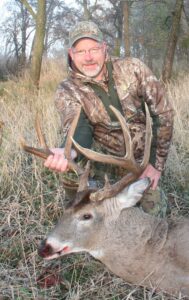
Find The Killing Tree
That’s not the only great location I know of. Some of them are only good with certain crop rotations or other annual changes; and some of them are good every year. What makes them great is that the deer will always do what deer have always done with relation to certain terrain features when all other factors are equal. Cameras will help you find these spots to some degree, but to really pinpoint these little hunting gold mines, there’s no substitute for in-person experience; you need to hunt them to really figure them out.
We started with a broad approach and worked our way down; from choosing the right state, to choosing the best areas within that state and on to picking the properties where we will hunt. Now that we are on site, we are going to choose our specific hunting location, right down to which tree we are going to use to kill that big buck.
In my years of hunting public land in so many states, I have found that the entire process almost always comes down to one or two specific locations. After all the work is done before the trip, and the scouting, trail camera checking, hunting and observation takes place in the first few days of the hunt, it always seems to focus down on one, sometimes two, specific spots where I go all in. Usually there is one place where I decide to push all my chips into the middle and live or die there. Choosing this spot is all about confidence.
The Confidence Factor
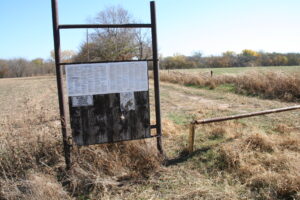 When I first started doing these DIY road trips, I would arrive at a location and I couldn’t wait to get in a tree and start hunting. I often would find an area all tore up with rubs and scrapes and I would put up a stand and start hunting it. That proved to be an ineffective method of hunting. One of the reasons was a lack of confidence in the spot.
When I first started doing these DIY road trips, I would arrive at a location and I couldn’t wait to get in a tree and start hunting. I often would find an area all tore up with rubs and scrapes and I would put up a stand and start hunting it. That proved to be an ineffective method of hunting. One of the reasons was a lack of confidence in the spot.
I’d be sitting in that great looking spot and I would hear bucks fighting just over the ridge from me, or I’d see a buck cruise down the crest of a saddle a hundred yards away, or maybe I’d see a line of does working down a trail out of range and I would wonder what’s over that ridge… is it a spot better than the one I’m in? I would quickly lose confidence in my spot and I would spend time looking for other spots when I should have been hunting. I would invariably end up going back at the end of the hunt to take that first stand down and realize it wasn’t in that good of a spot after all.
Before I ever put up the first stand these days, I want to fully know the area. I want to know what is over that ridge. I want to know what’s on that saddle and I want to know where those does were going. Then when I finally choose my spot to hunt, I can climb in the stand with the confidence that I am in a good spot and I’m not continually second-guessing myself. Nothing makes it harder to stay on stand all day than a lack of confidence in your location.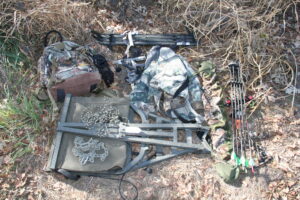
The Value of Scouting
There is no substitute for covering a lot of ground on foot. Put on a good pair of comfortable boots and put on some miles. I carry a backpack with trail cameras, some granola bars and drinks, deer scents, GPS, camera and lane trimming tools.
Back home you probably have deer hunting land that you try to manage. You are somewhat familiar with the deer’s tendencies on that land. You know where the bedding areas are and you stay out of them. You may even have areas that are considered inviolate that you never set foot into. If you are on a DIY hunt in a new area you have none of those luxuries. You need to find those places, and sometimes identifying them means taking risks that you would never consider on property that you hunt all the time.
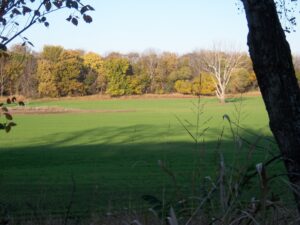 You have to hunt and scout aggressively. You’ll bust some deer out of their beds. I hate that, but if you are going to learn the lay of the land it’s a fact of life. They may or may not be back the next day, but over time they will be back there; it’s a preferred bedding area for a reason. Deer on public lands are more accustomed to being bumped, then quickly going back to their normal patterns than most people realize. Walking a creek or ditch while looking for a crossing is a good way to intersect trails. These crossings often turn out to be good stand locations.
You have to hunt and scout aggressively. You’ll bust some deer out of their beds. I hate that, but if you are going to learn the lay of the land it’s a fact of life. They may or may not be back the next day, but over time they will be back there; it’s a preferred bedding area for a reason. Deer on public lands are more accustomed to being bumped, then quickly going back to their normal patterns than most people realize. Walking a creek or ditch while looking for a crossing is a good way to intersect trails. These crossings often turn out to be good stand locations.
I use lures in scrapes and put cameras over them. I like the scrape drippers made by Wildlife Research Center and I use their Active Scrape lure and Special Golden Estrus to get the deer in front of my cameras. It’s hard to beat using a trail camera on a big scrape with fresh urine or quality deer lures when it comes to getting a quick inventory of the bucks on the property.
Observation Stands
I rarely hunt the first day I arrive at a new location. I usually try to find a vantage point where I can observe activity through binoculars during the evening hours. There is so much more information to be gathered by observation than by getting in a tree that first day. You’ll see how much hunting pressure the area is getting, if any. You’ll be able to observe the stage of the rut by observing deer movements. You might even find a great stand site by observing where the deer activity is concentrated.
Even when I do put up the first stand, it’s likely to be what I call an “observation stand” meaning that it is in a location where I can see a distance. This may be the edge of a field where I can see the entire field, or it may be on top of a ridge where I can observe deer traffic before actually moving the stand right onto a more specific location.
We all want to get in the stand and hunt right away, but trust me, a more methodical approach will pay off in the long run. If you go back to this same property in future years, you will have much of the actual legwork done so you can attack much sooner. But for the first time, not taking time to familiarize yourself with the area is a recipe for failure.
I like to start with one stand near an area that I can see visible feeding activity. I want to know where the does are spending most of their time on any rut hunt. In many cases that stand will be on the edge of a field or food plot. The observations from that stand will usually lead me to move it to an entry trail, a staging area or a trail that parallels the edge of the field where bucks will work inside the woods to scent check the does. Once I have the stand and equipment out there, I have a lot less work to do when it comes time to move it to a more specific location.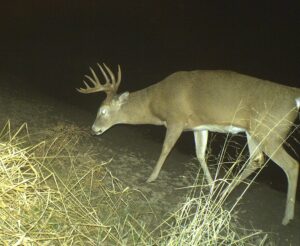
One time I put a stand right on top of an oak ridge because the deer’s movements were not readily identifiable even though they were feeding all through the area. Following the first evening in that stand, I could clearly see which direction the majority of them came from and I moved the stand down the ridge 100 yards and filled my tag the next evening.
Setting on Sign and Instinct
Because you have never been to the area before, you have little choice but to make your stand placement decisions on a combination of sign and instinct. The easiest part of that equation of course is the sign. You want to find not just sign but fresh sign. Fresh rubs, scrapes that are getting worked, evidence of feeding such as plants nipped off and ears of corn pulled off the stalks, fresh beds, fresh tracks in the trails; these are all evidence of recent activity that helps you gain confidence that you are in the right spot.
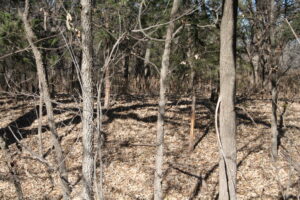 First person observation is the way to read the sign and to do that you need to get out there and cover the ground. Get to know the area well, and you will have a much better view of the overall picture, which will help you in your decision making process about where exactly you are going to spend your valuable hunting time.
First person observation is the way to read the sign and to do that you need to get out there and cover the ground. Get to know the area well, and you will have a much better view of the overall picture, which will help you in your decision making process about where exactly you are going to spend your valuable hunting time.
The more you do this, the more you will have gut feelings about certain things you see. There is no substitute for time in the woods and experience. When you find yourself looking around you and saying, “This place just feels right.” Then you will know you’re well on your way. The instincts that make you great at choosing great spots must be developed over time. The more time you spend at it, the better you become.
